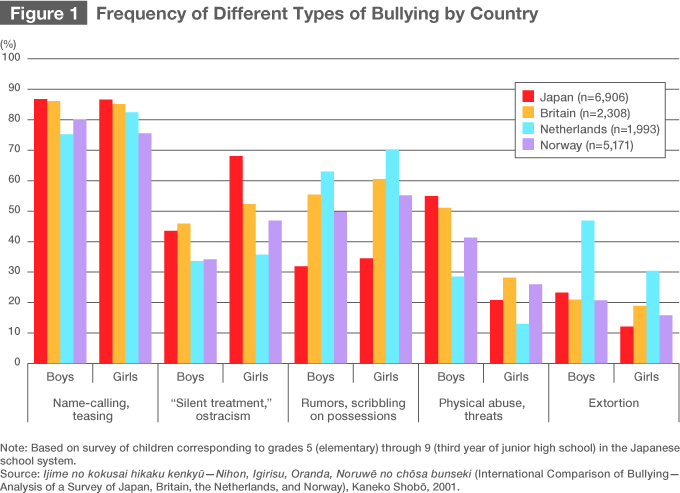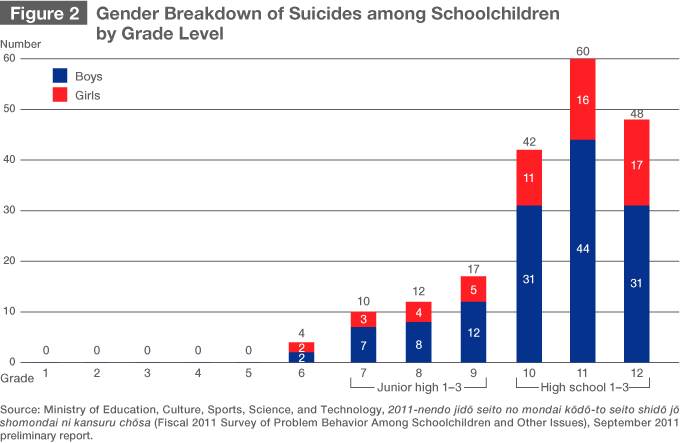
Anatomy of Japanese Bullying
Society Culture- English
- 日本語
- 简体字
- 繁體字
- Français
- Español
- العربية
- Русский
Bullying occurs among children in every part of the world, and wherever it occurs, it displays certain common features. Yet we can also discern differences in respect to the prevalence of different types of bullying, the response of victims, and the attitudes of onlookers. By analyzing these similarities and differences we can begin to grasp the cultural and socioeconomic factors underlying the school bullying that has emerged as a major social problem in Japan.
General Patterns
Throughout the world, the most common form of bullying is name-calling or teasing, as suggested by the results of an international survey from 2001 (figure 1). This is a relatively easy, low-risk, mild form of harassment, and as such it tends to occur frequently in all cultures, especially at the early stages of bullying. Physical bullying, on the other hand, tends to be more prevalent in societies where violence is common and people must compete to survive. In societies that emphasize survival of the strongest and allow social and economic resources (income, status, educational opportunity, etc.) to become concentrated in the hands of the few, one sees a decline in morals and an increase in rule breaking. These tendencies in adult society are apt to be reflected in the way children relate to one another.
According to the frustration-aggression hypothesis, aggression toward the innocent and those who pose no threat occurs when people are unable to direct their aggressive feelings toward the actual cause of their frustration. Among children, it is clear that the incidence of bullying behavior is higher among those who experience frustration as a result of stresses at school or in the home. For this reason, one way to reduce bullying is to provide counseling to the perpetrators.
While schoolyard bullying has traditionally been the prerogative of the strong, the Internet, cellphones, and other advanced information and communications technology have made it possible for virtually anyone to vent his or her frustration anonymously—and sometimes under the name of other people—through online verbal bullying. In a world where anyone with pent-up frustrations can become a cyber-bully, the question for parents and educators is how to raise children who can deal with their frustrations without resorting to bullying.
Schoolyard bullies are often popular, intelligent children with good social skills. Children who are well liked by their peers and trusted by teachers and other adults are best able to drum up support for their bullying campaigns while concealing them from authorities.
Patterns in Japanese Bullying
During the lean years in Japan immediately following World War II, when violence and crime were relatively common, bullying reflected the kind of “survival of the strongest” ethic discussed above. In such societies, bullying is regarded not only as inevitable but as a natural and essential part of growing up and joining society. Children are taught that it is better to bully than to be bullied, and the victims tend to receive blame rather than sympathy.
Although the severe shortages and relative lawlessness of the immediate postwar years may be a thing of the past, the economic disparities that have grown since the collapse of the 1980s bubble economy are once again creating a hard-scrabble society of haves and have-nots. Children raised in an environment where the haves flourish at the expense of the have-nots are more likely to engage in systematic persecution of the weak. This is the kind of bullying that led to the suicide of a second-year junior high school student in Ōtsu (Shiga Prefecture) in October 2011 and that of a third-year high school student in Kobe in 2007, both of which were provoked by a series of physical assaults more properly described as criminal behavior. This is sometimes called “pecking-order bullying.” The term pecking order refers to the social hierarchy observed among chickens, who express their dominance by pecking; the strongest birds peck at weaker ones, who, in turn, peck at the even weaker birds. At feeding time, the stronger birds chase away the weaker ones, and the pecking order determines the order in which the chickens eat. This behavior comes into play particularly when there is insufficient food (or, in human society, resources) to go around.
In addition to physical aggression against the victim’s person or belongings (more common among boys), bullying often takes the form of relational aggression (more common among girls), which involves alienating the victim from his or her peers through gossip, ostracism, or “the silent treatment.” School-age girls tend to rely heavily on their relationships within a peer group for happiness and a sense of security, and they place great value on an almost constant flow of verbal communication with their friends. While boys also find security in a peer group, they are more likely to cement and affirm these relationships through physical activity, such as participation in sports, rather than conversation. A glance at figure 1 confirms that silence and ostracism are a more common means of bullying among girls than among boys.

Figure 1 also reveals that relational aggression is particularly prevalent in Japan. In a society that places strong emphasis on the individual’s place within the group, any form of bullying that damages a person’s relationship with the group is highly stressful and therefore especially potent. Relational aggression is less damaging to people who are comfortable going their own way and are brought up with the notion that each individual is unique—a mode of thought more often found in Western societies.
A longitudinal study carried out from 2004 to 2009 by the National Institute for Educational Policy Research looked at the number of Japanese seventh-graders (first-year junior high school students) who had experienced “the silent treatment, ostracism, or gossip” as of June 2004 and then sampled the same group of children in the same manner two years later in November 2006. The survey found that the ratio had risen from 41.6% to 80.3%. The study also found that of a sample of fourth-grade students surveyed in 2004, a full 90.3% had experienced such relational aggression by 2009, when they were ninth-graders.
Bystanders and Collective Self-Defense
One of the questions asked in the international survey was, “If you see someone being bullied, do you intervene to stop it?” It was found that in countries other than Japan, the percentage of “yes” responses rises fairly steadily with the age of the respondents. In Japan, however, the percentage of affirmative responses drops during the four years corresponding to grades 5 through 8, which is also the period when bullying tends to be most prevalent. In other words, during early adolescence Japanese children are more apt to ignore bullying, or to look on without taking action, than they are before or after that age. The collective will of the peer group is a set of unspoken assumptions that pervades the environment and influences children’s response to a particular situation.
Another factor to consider is whether victims of bullying are more likely to blame themselves (intropunitive) or the bully (extrapunitive). Severe bullying is more apt to lead to suicide when the victim's response is intropunitive; when the response is extrapunitive, it is more likely to lead to acts of revenge. In societies that emphasize individualism and self-reliance, it is more common for victims of bullying to blame the bully and take independent steps to defend themselves. In a group-oriented society like Japan's, where individuals often feel compelled to correct any personal shortcomings or differences that could subject them to disapproval by the group, people are more apt to blame themselves if criticized or slighted by others. They are also more likely to rely on members of their peer group for support and protection. And since almost all bullying in Japan takes place within the peer group, victims of bullying are being abused by the very people who should be defending them. Dependence on the group and an intropunitive tendency may exacerbate the suffering of Japanese bullying victims and contribute to the high incidence of juvenile suicide.
According to Ministry of Education, Culture, Sport, Science, and Technology (MEXT), in fiscal 2011 there were 27 reported suicides by boys and 12 by girls among junior high school students and 106 reported suicides by boys and 44 by girls among high school students (figure 2). Statistics released by the National Police Agency, meanwhile, indicate that about 70% of all suicides between 1998 and 2010 were by males. While neither agency has specified bullying as among the causes for the suicides, it seems reasonable to conclude from the existing data that bullying-related suicides are also two to three times more prevalent among boys than among girls.

Experts believe that this is because girls are more likely to talk to others when they are under stress or in trouble, and for this are more likely to be noticed and receive help. Boys are more apt to keep silent and try to take care of things on their own. In the end, they blame themselves and, seeing no way out, are more likely to take their own lives. This means we must work harder to teach boys to confide in others when they have problems instead of keeping them bottled up inside.
We also need to provide a more supportive environment. One way is to create more opportunities for interaction among children of different age groups. (In traditional Japanese society, with its age-based hierarchical relationships, socialization occurred largely in the context of mixed-age groups.) Another way is to provide children with more opportunities to build warm and supportive relationships with adults. At the same time, we must redouble our efforts to teach children that bullying is cruel and socially unacceptable behavior.
(Originally written in Japanese on October 4, 2012)
Reference
1) Child Research Net http://www.childresearch.net/
2) Morita Yohji, Ijime no kokusai hikaku kenkyū—Nihon, Igirisu, Oranda, Noruwē no chōsa bunseki (International Comparison of Bullying—Analysis of a Survey of Japan, Britain, the Netherlands, and Norway) , Kaneko Shobō, 2001
3) Watts, M. (1998), Cross-Cultural Perspective on Youth and Violence, JAI Press
4) National Institute for Educational Policy Research “Ijime tsuiseki chōsa 2007-2009” (Pursuit Surveys on Bullying 2007~2009)
suicide education school children Sugimori Shinkichi bullying frustration schoolyard physical verbal violence high school aggression assault peer victim ostracism group friends adolescence boys girls individualism juvenile